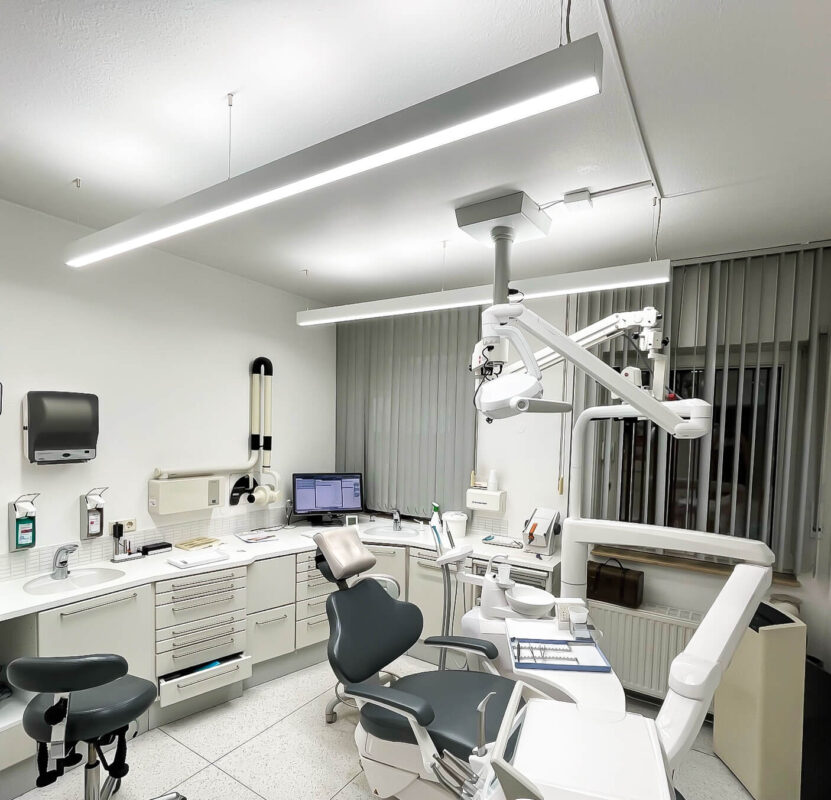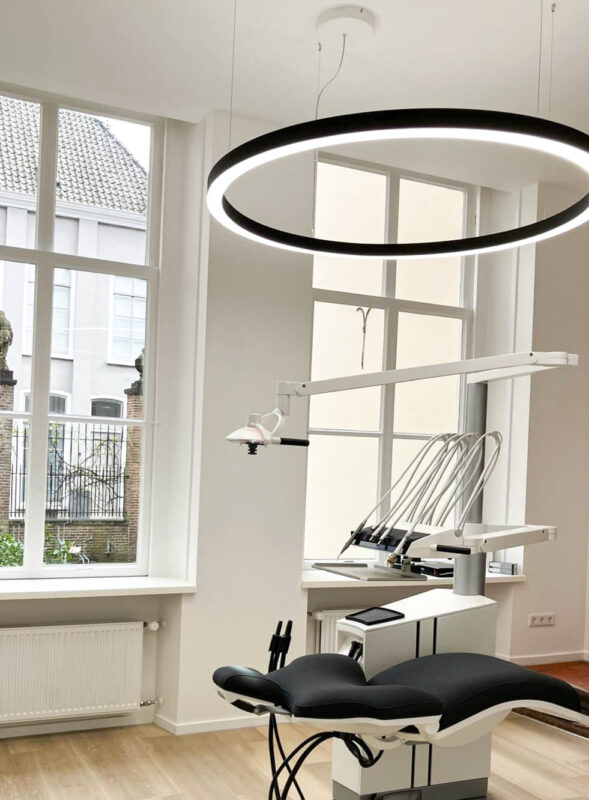Adaption and Accommodation in the Eyes — Why Correct Lighting in the Dental Treatment Room Is Essential for Ergonomics and Visual Comfort
Introduction
This article is part of our series on factors that cause fatigue in dental professionals and how ergonomic lighting design can help prevent it.

For dentists and dental hygienists, tired eyes are among the most common sources of end-of-day exhaustion. The constant alternation between bright operating lamps and darker surroundings forces the eyes to adapt repeatedly, creating visual fatigue that affects concentration, comfort, and posture.
Dentistry depends on sustained visual precision — detecting color nuances, working in confined spaces, and maintaining focus for hours. These tasks rely on two visual mechanisms: accommodation, which adjusts focus between near and far, and adaption, which regulates brightness sensitivity. When lighting is unbalanced, adaption and accommodation are overworked, leaving the eyes — and the dentist — tired and strained.
Understanding these processes explains why correct, evenly distributed lighting in dental treatment rooms is not a luxury but an ergonomic necessity.
Two fundamental visual processes — accommodation (focusing between near and far) and adaption (adjusting to different light levels) — are constantly at work in every dental procedure. When the lighting in the dental treatment room is unbalanced or poorly distributed, these mechanisms are overstrained, leading to eye fatigue, loss of concentration, headaches, and eventually musculoskeletal tension.
Understanding how accommodation and adaption function — and designing lighting that supports them — is at the heart of ergonomic lighting for dentistry. This is why correct lighting for dental treatment rooms, with balanced full daylight spectrum LED illumination, is essential to safeguard both visual health and clinical precision.
Key Takeaways
- Accommodation allows the eyes to shift focus between near and far distances (e.g., between patient’s mouth, instruments, and monitor).
- Adaption (adaptation) enables the eyes to adjust to changes in brightness (e.g., bright operating lamp vs dim ambient light).
- Poor lighting contrast, low CRI LEDs, and insufficient ambient illumination increase visual workload and fatigue.
- Optimal lighting for dental treatment rooms should provide:
- 1,500–2,000 lux around the patient’s mouth (working field)
- ≥700 lux in the surrounding room
- Light contrast ratio ≤10:1 between operating light and ambient light
- Uniform, shadow-free, flicker-free illumination
- Full-spectrum, high-CRI LED lighting that mimics natural daylight
- Balanced lighting improves ergonomics for dentists, visual comfort, and overall performance during dental procedures.
- 1,500–2,000 lux around the patient’s mouth (working field)
1. Visual Demands in the Dental Treatment Room
Dentistry requires continuous visual precision — detecting microfractures, assessing shade differences, and maintaining focus at short working distances for hours. These visual tasks depend on:
- High illuminance levels for clarity
- Accurate color rendering to distinguish tissues and materials
- Evenly distributed light to prevent sharp shadows or glare
Studies have shown that uneven lighting and excessive contrast between the working field and the surrounding room trigger repetitive accommodation and adaptation cycles, leading to visual strain and fatigue (MedCrave Journal of Dentistry, 2020; Dimensions of Dental Hygiene, 2018).
2. What Is Visual Accommodation?
Accommodation is the process by which the eye’s ciliary muscles adjust the curvature of the crystalline lens, allowing the eye to focus on near or distant objects.
- In dentistry, this means rapidly shifting focus between:
- The patient’s mouth (≈ 30–40 cm distance)
- Dental instruments or mirror reflections
- Monitor screens or assistants
- The patient’s mouth (≈ 30–40 cm distance)
- Constant refocusing places a muscular load on the eyes, especially when lighting contrast is high or edges are poorly defined.
- Low-contrast lighting or shadows increase this effort, accelerating eye fatigue and reducing visual accuracy.
Scientific reference:
Accommodation mechanisms are well described by Ciuffreda & Rosenfield (Annual Review of Vision Science, 2020), who note that near-work environments with poor lighting dramatically increase accommodative stress.
4. How Lighting Design Impacts Dental Ergonomics
Correct lighting design for dental treatment rooms minimizes the strain from adaptation and accommodation. Ergonomic lighting supports visual stability, color accuracy, and comfort, allowing dentists to focus on procedures rather than their eyes adjusting.
Recommended Lighting Parameters
Lighting Zone | Recommended Illuminance | Purpose |
Working field (patient’s mouth) | 1,500–2,000 lux | Optimal precision and shade matching |
Ambient/room lighting | ≥ 700 lux | Prevents visual adaptation stress |
Light ratio (max/min) | ≤ 10:1 | Reduces adaptation load |
Color Rendering Index (CRI) | ≥ 97 (full daylight spectrum) | Natural color perception |
UGR (Unified Glare Rating) | < 19 | Reduces glare and discomfort |
Flicker | < 1% modulation | Prevents neurological and visual strain |
Design Strategies
- Use bi-directional lighting (direct + indirect) for uniform brightness.
- Avoid dark corners or high-contrast transitions between ceiling and walls.
- Integrate flicker-free, full-spectrum LED lighting that replicates daylight (5,500–6,000 K).
Choose lighting layouts that distribute brightness evenly, such as DentLED’s PHL and PVR series, which combine vertical and horizontal illumination.

5. Ergonomics for Dentists: Beyond Posture
While dental ergonomics often focuses on posture and musculoskeletal strain, visual ergonomics is equally important.
- Eye fatigue affects concentration, accuracy, and even body posture.
- Dentists with visual fatigue tend to lean forward or reposition to improve visibility, increasing neck and back strain.
- Correct, evenly distributed lighting allows relaxed viewing and supports neutral posture throughout long procedures.
Reference:
A 2022 review in the International Journal of Environmental Research and Public Health confirms that visual ergonomics and adequate lighting directly influence physical posture and musculoskeletal health among dental professionals.
6. Benefits of Full Daylight Spectrum Lighting
Modern full-spectrum LED lighting (CRI ≥ 97) closely replicates natural daylight, improving color discrimination, contrast sensitivity, and visual comfort.
- Enhances accuracy during dental procedures such as shade matching, endodontics, and cosmetic restorations.
- Reduces adaptation strain by providing a balanced spectral distribution across the entire workspace.
- Promotes overall well-being and circadian balance, which are increasingly recognized components of healthy lighting for healthcare environments.
7. Conclusion
Visual comfort in dentistry is not a luxury — it is an ergonomic necessity.
By understanding accommodation and adaption, and applying scientifically based lighting design principles, dental professionals can protect their eyes, improve performance, and sustain focus throughout the day.
A well-illuminated dental treatment room — using DentLED full daylight spectrum lighting — ensures that the light level difference between operating and ambient zones is balanced, shadows are eliminated, and every detail remains clear and natural.
Healthy eyes work better — and for longer — under healthy light.

